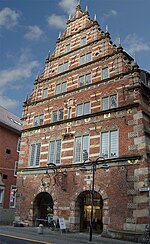Lüder von Bentheim
Lüder von Bentheim (* around 1555; † 1613 ) was a Bremen stone merchant and architect of the Weser Renaissance .
biography
Lüder von Bentheim was born the son of a master stone mason who had immigrated from Holland and who had numerous commissions in Bremen. His grandfather was a rent manager in Rheda . He took over his father's profession and took the Bremen citizen oath in 1579 . This is the first written mention of his person. He then devoted himself increasingly to the work as an architect. Received a large number of construction contracts that he carried out with numerous employees. In 1595 he was appointed by the city to deserve the mercy of Stenhower .
Von Bentheim was the leading master builder for the buildings of the Weser Renaissance in Bremen. After his death, his son Johannes (1584–1653) continued his work.
Works
At the beginning of his career, the still almost unknown young architect received several small orders. The first demonstrable was a work on the Bremer Ansgariitor from 1581/82. Then in 1583 he enlarged the bride , the most famous of the Bremen powder towers . In 1584, various houses on the Domshof and the meat banks on the market square were restored under his leadership . Two years later he was working on the Weser Wall.
He preferred sandstone as a building material . He had this transported on Weser barges from the Upper Weser region to Bremen.
City scales
In 1587 von Bentheim designed his first own building, the Bremer Stadtwaage . With this building he initiated the phase of the Weser Renaissance in Bremen.
The characteristic facade consists of bricks, at regular intervals of kerf-decorated Boss stones to be replaced. The upward-tapering pediment has pilasters on each landing , and the windows are crowned with shell-shaped elements.
Two arched gates led directly into the spacious weighing hall, while storage floors for grain were available on the upper floors.
Kornhaus
In 1591 he planned the construction of the granary . The sandstone facade was very similar to that of the city scales and had numerous small Renaissance gables. The granary was destroyed after an air raid in 1944 and was never rebuilt.
Works around 1591 to 1595
This was followed by a phase of around four years in which Lüder von Bentheim again only carried out smaller orders. During this time he did not design any buildings, but contented himself with extending or redesigning existing ones. The buildings included:
- the Rathsapotheke
- the Bremen northwest bastion in the Bremen ramparts
- the Blumenthaler Church in Blumenthal
- the castle Bederkesa
- the Roland statue in Bederkesa Castle
Bremen town hall
In 1595 Lüder von Bentheim began to work at the Bremen town hall . He replaced the simple market square front with an extremely elaborate Weser Renaissance facade. This is supported by numerous arcades. In front of the roof were three gables, of which the middle one stands out as the main piece. Inside the town hall, the architect designed the Güldenkammer, a small room for consultations, which is equipped with gold-embossed leather wallpapers. The work on the town hall dragged on for 18 years and was completed in 1613, the year Bentheim died.
Outside of Bremen and its land area
During his work on the Bremen town hall, Lüder von Bentheim was still significantly involved in the execution (not the design) of other buildings: In Leiden he modernized the Gothic town hall in the Renaissance style and the Rijnhuis, the shipping administration. In addition, he organized the export of Obernkirchen sandstone, like the one he used in Bremen, to the Netherlands for other buildings .
Honors
- The Lüder-von-Bentheim-Strasse in Schwachhausen was named after him.
- The Bremische Lüder von Bentheim-Gesellschaft existed from 1901 to around 1916. It was founded again in 1961. In 1961 it spoke out against the modern new building for the Bremen citizens and wanted gabled houses to be built there.
- A boat replica was christened Lüder von Bentheim in 2001 . The replica was carried out by Bremer Bootsbau in Vegesack, after two Weser barges from the 16th century were salvaged near Rohrsen in 1999 and are exhibited in the Weser Renaissance Museum in Brake Castle. The ship is used by the Bremer Fahrgastschifffahrtsgesellschaft Hal över for shuttle trips on the Weser .
literature
- Doris Blümlein: Bentheim, Lüder von. In: New German Biography (NDB). Volume 2, Duncker & Humblot, Berlin 1955, ISBN 3-428-00183-4 , p. 56 ( digitized version ).
- Herbert Black Forest : The Great Bremen Lexicon . 2nd, updated, revised and expanded edition. Edition Temmen, Bremen 2003, ISBN 3-86108-693-X .
Web links
Individual evidence
- ↑ Stephan Albrecht: The Bremen town hall in the sign of urban self-expression before the 30 years war. Marburg 1993.
- ↑ Stephan Albrecht: A facade belongs to travel .... In: Bremen and the Netherlands , 1995/96 year book of Wittheit zu Bremen, Bremen: Hauschild, 1997, pp. 69–73
- ↑ Die Zeit: Dispute about the Bremer Giebel , No. 46 (from November 10, 1961)
| personal data | |
|---|---|
| SURNAME | Bentheim, Lüder from |
| BRIEF DESCRIPTION | Bremen stone merchant and architect of the Weser Renaissance |
| DATE OF BIRTH | around 1555 |
| DATE OF DEATH | 1613 |



